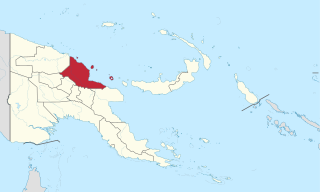Related Research Articles

Kaiser-Wilhelmsland formed part of German New Guinea, the South Pacific protectorate of the German Empire. Named in honour of Wilhelm I, who reigned as German Emperor (Kaiser) from 1871 to 1888, it included the northern part of present-day Papua New Guinea. From 1884 until 1920 the territory was a protectorate of the German Empire. Kaiser-Wilhelmsland, the Bismarck Archipelago, the northern Solomon Islands, the Caroline Islands, Palau, Nauru, the Mariana Islands, and the Marshall Islands comprised German New Guinea.

Madang is a province of Papua New Guinea. The province is on the northern coast of mainland Papua New Guinea and has many of the country's highest peaks, active volcanoes and its biggest mix of languages. The capital is the town of Madang.

Morobe Province is a province on the northern coast of Papua New Guinea. The provincial capital and largest city is Lae. The province covers 33,705 km², with a population of 674,810, and since the division of Southern Highlands Province in May 2012 it is the most populous province. It includes the Huon Peninsula, the Markham River, and delta, and coastal territories along the Huon Gulf. The province has nine administrative districts. At least 101 languages are spoken, including Kâte and Yabem language. English and Tok Pisin are common languages in the urban areas, and in some areas pidgin forms of German are mixed with the native language.
The Left May or Arai languages are a small language family of half a dozen closely related but not mutually intelligible languages in the centre of New Guinea, in the watershed of the Left May River. There are only about 2,000 speakers in all. Foley (2018) classifies them separately as an independent language family, while Usher (2020) links them with the Amto–Musan languages.
The Abinomn language is a likely language isolate initially reported by Mark Donohue from Papua province, Indonesia. It is also known as Avinomen, Baso (deprecated), and Foia. There are about 300 speakers.
The Gogol River is a river in Madang Province, Papua New Guinea. It empties to Astrolabe Bay at 5.316667°S 145.75°E.
Marik, or Ham, is an Austronesian language spoken by 3,500 people in 10 villages around the Gogol River, Madang Province, Papua New Guinea.

The Kaure–Kosare or Nawa River languages are a small family spoken along the Nawa River in West Papua, near the northern border with Papua New Guinea. The languages are Kaure and Kosare.
The Northern Adelbert or Pihom–Isumrud languages are a family of two dozen languages in the Madang stock of New Guinea. The occupy the coastal northern Adelbert Range of mountains, vs. the Southern Adelbert languages, another branch of Madang.

The Bulaka River languages are a pair of closely related Papuan languages, Yelmek and Maklew, on the Bulaka River in Indonesian West Papua. They are ethnically Yab (Jab); their speech is Yabga (Jabga).
Adolph von Hansemann was an Imperial German businessman and banker.
Nobonob, also known as Butelkud-Guntabak or Garuh, is a Papuan language of Papua New Guinea. The language is expanding slightly. Ari is a dialect.
Wagi, also known as Kamba or Foran, is a Papuan language of Papua New Guinea.
Bagupi is a nearly extinct Madang language of Papua New Guinea. The language is under pressure from neighboring large languages such as Garuh, and Tok Pisin, which is taking its toll. Spoken in the Madang Province of Papua New Guinea. Spoken at the headwaters of the Gogol River, west of Mabanob, northwest of Madang town. Very little is still known about this unique language situated in Papua New Guinea.

Hansemann Mountains is a mountain range in Papua New Guinea. It was named after Adolph von Hansemann. Hansemann Mountains are located near town of Madang.
The Doso–Turumsa languages are a pair of closely related languages spoken along the Soari River of New Guinea, namely Doso and Turumsa, that appear to be closest to the East Strickland languages.
The South Pauwasi languages are a likely small language family of New Guinea, potentially consisting of Yetfa, Kimki, Lepki, Murkim and Kembra.
The Northwest Papuan languages are a proposed language family of Papuan languages
Hansemann is a surname. Notable people with the surname include:
The Lepki–Murkim languages are a pair to three recently discovered languages of New Guinea, Lepki, Murkim and possibly Kembra.
References
- ↑ Hammarström, Harald; Forkel, Robert; Haspelmath, Martin, eds. (2017). "Hanseman". Glottolog 3.0 . Jena, Germany: Max Planck Institute for the Science of Human History.
- ↑ Hansemann Range, NewGuineaWorld